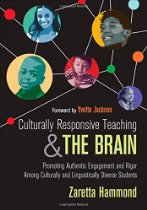Culturally Responsive Teaching and the Brain: Promoting Authentic Engagement and Rigor among Culturally and Linguistically Diverse Students
 This is a book by Zaretta Hammond which was published this year by Corwin Press and is an excellent reference even for those of us working in adult education. Hammond takes us through the brain processes which both lead us to stereotype and yet also make us by and large very susceptible to empathy and how all this relates to optimal learning processes. It also explains the reason why negative experiences loom so large and are retained long after their usefulness has expired and how constant negative, micro-aggressions lead to primal responses led by the reptilian brain.
This is a book by Zaretta Hammond which was published this year by Corwin Press and is an excellent reference even for those of us working in adult education. Hammond takes us through the brain processes which both lead us to stereotype and yet also make us by and large very susceptible to empathy and how all this relates to optimal learning processes. It also explains the reason why negative experiences loom so large and are retained long after their usefulness has expired and how constant negative, micro-aggressions lead to primal responses led by the reptilian brain.
The book also gives through some basic intercultural theory in just enough detail to note that in an American context, most other cultures are much more collectivist than individualist and this has big implications for how to handle motivation and work flow in the classroom. This would be still relevant in a European context but slightly less so.
The rest of the book is about working with others both students and colleagues, to create an efficient learning community. This means that the book is light on lesson plans (there are none) but big on the collaboration needed among staff, school management and others to create an atmosphere in which students are valued for what they can bring, their innate skills and how to facilitate their development. For those of us in adult education, a certain amount of translation is needed to get the most out of the book but it is precisely this emphasis on creating an inclusive atmosphere with learning as its goal which is wholly transferable across sectors. Perhaps some of the case studies would need to be a little different for adult education but that is an interesting professional development exercise in itself. So buy the book and supply your own case studies!
Hammond’s approach can be summarised in the Ready for Rigor Framework which you can find on her website, which is also a treasure trove of resources and information about CRT. The R4R Framework has four quadrants comprising:
- Awareness (relating intercultural knowledge of yourself and your classroom)
- Information Processing (strategies that promote learning)
- Learning Partnerships (the student -teacher relationship)
- Community of Learners and Learning Environment (the class relationship)
As you read through the book you find many concepts which are taking hold across the educational sector as best practice, but here with an intercultural twist. These include but are not restricted to:
- promoting a growth mindset
- giving students agency
- building knowledge about each individual student
- giving effective and frequent feedback
But in the end, it all comes down to relationships. A great example is the pact that Hammond advocates teachers to have with their students. These can be formal agreements, which are already found in many educational institutions but which are mostly compliance based or they can be an agreement between the teacher and student as a result of respectful dialogue and buy-in from both sides and this need not be written down. The latter is the more effective, meaningful and culturally responsive. In coaching terms this is about formulating SMART goals that are bought into by the coachee.
The video below shows one powerful example of how changing the relationship between student and teacher can give very positive learning results (again this is a K12 example rather than an adult ed example).
This book is an excellent starting point by a classroom practitioner.
Full disclosure: The link to the book takes you to the Absolutely Intercultural Amazon store where we have collected resources which we recommend for finding out more about intercultural communication. A small part of your payment goes to us to help produce the podcast and you don’t pay any more than if you were to search for the book yourself.